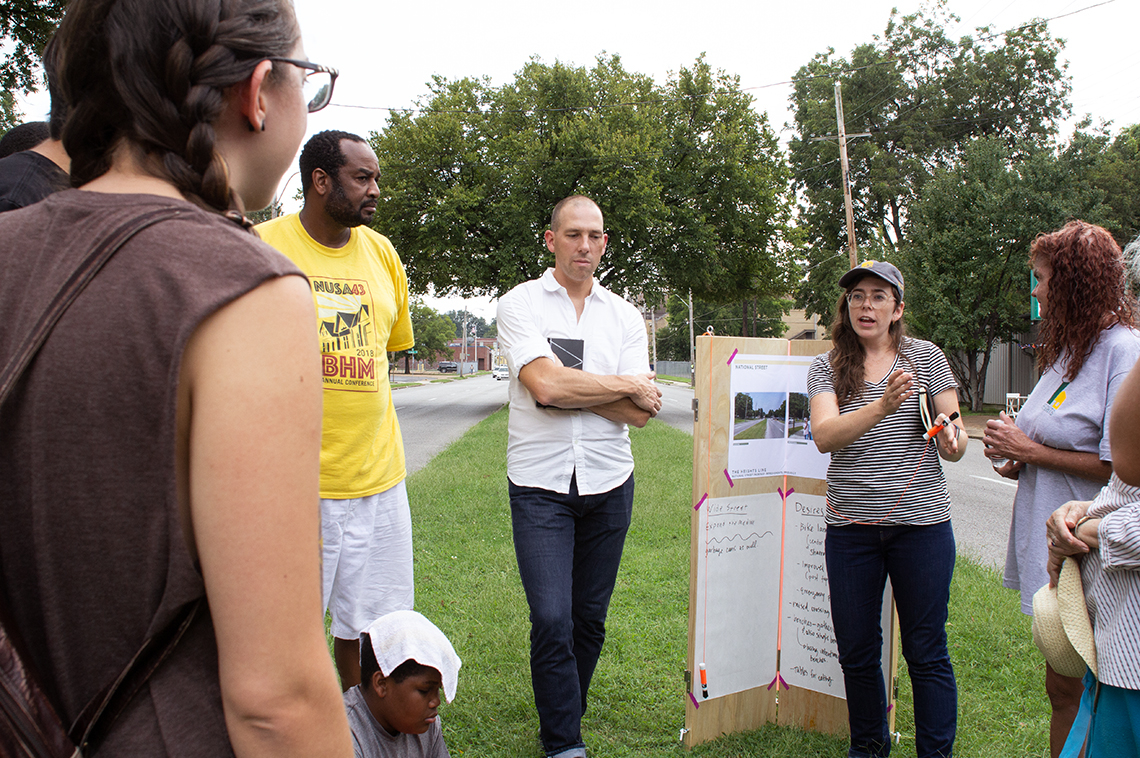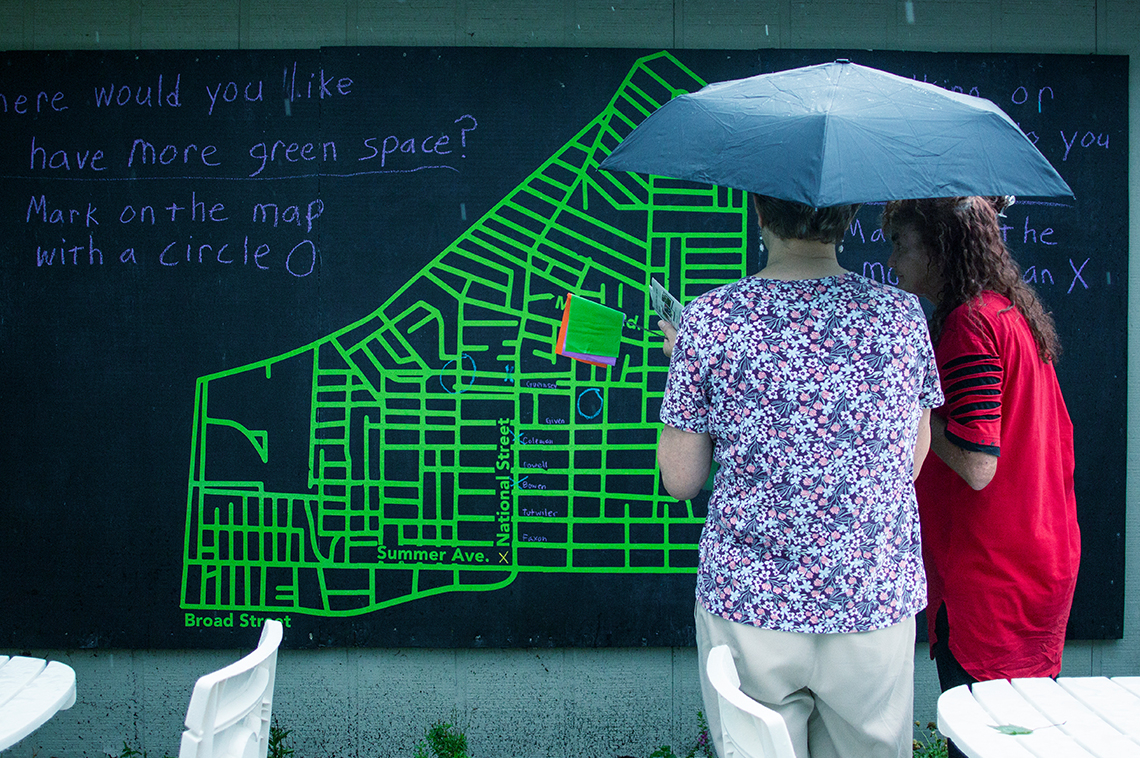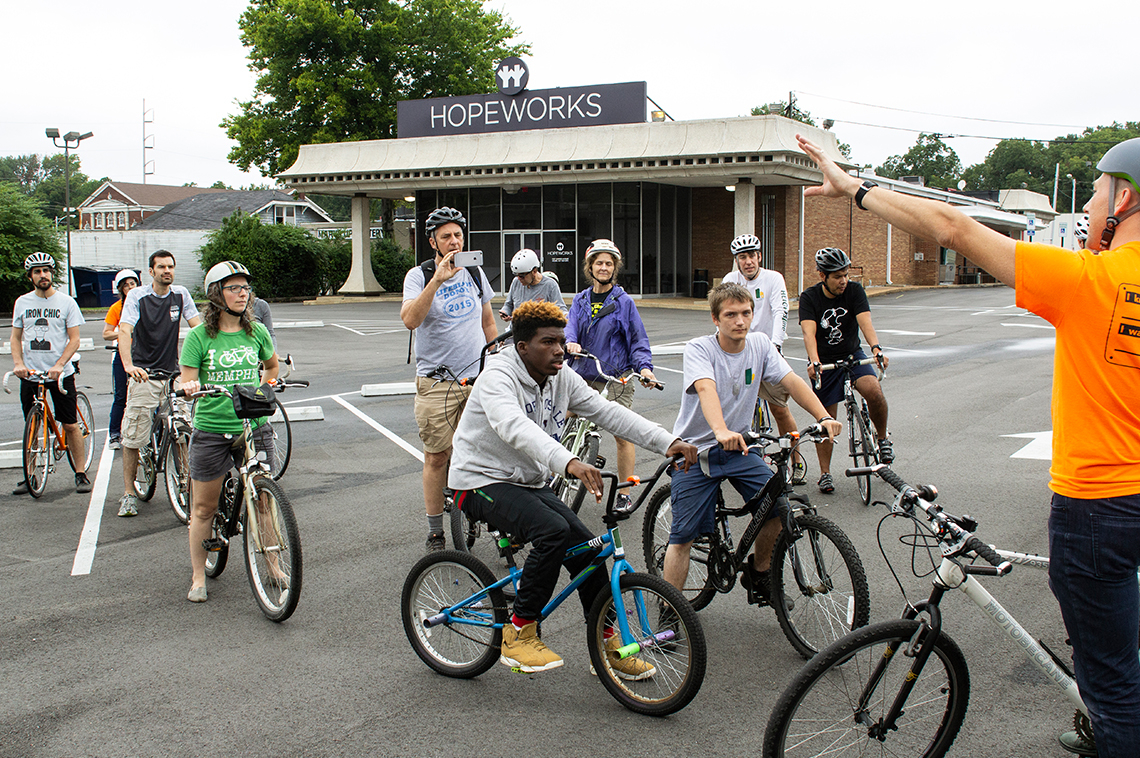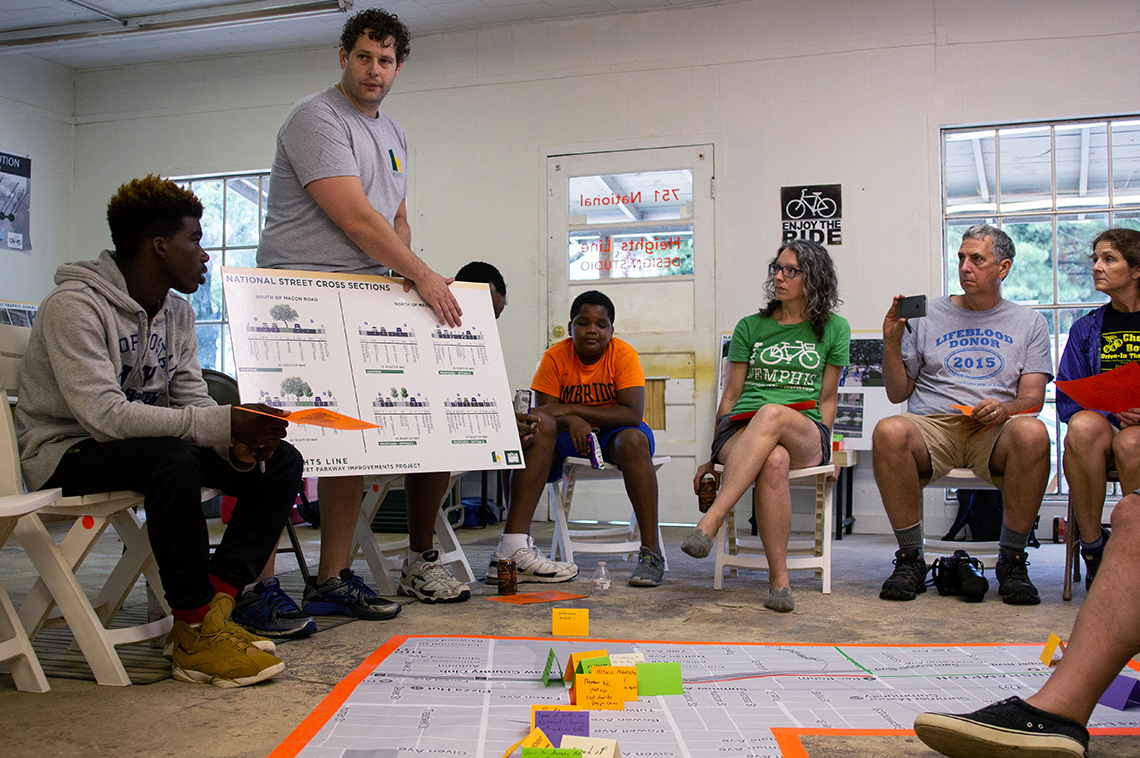



Like Riding a Bicycle is the name of our socially engaged art collective. We have been working together since 2014 to empower communities and individuals in the places they live. We are currently working with the Heights Community Development Corporation (CDC) in Memphis, Tennessee, to create community engagement programing that complements the development of a new neighborhood-led multimodal infrastructure project called the Heights Line.
“The place is already made”
Guiding our methodology is the belief that “the place is already made.” We are sometimes wary of the term “creative placemaking” because it implies that there is making to be done. We believe every location has a unique character, and while creative practice can amplify that character, we do not believe art should create some idealized version of a place. This runs the risk of replacing (or, in worst cases, whitewashing) deep-rooted cultural practices.
While saying “creative placemaking” is easy shorthand, those of us who do it know that there is nothing easy about this work! If we understand that the places we work in are already made, we can use those words while focusing on the tasks of making visible what is there, amplifying local ideas, and supporting the people that make the place what it is.
The Heights Line
The Heights Line is a proposed 1.75-mile linear green space and trail on National Street, a four-lane road that runs through the Memphis neighborhood the Heights, an area with a history of underinvestment. The Heights Line, currently in the design and planning phase, will connect the neighborhood to other existing and proposed green spaces, creating the first north-south route that will give Memphians access to dozens of miles of uninterrupted trails. Even more importantly, the project stands to connect neighbors by creating the only improved green space in the neighborhood. The Heights Line was initiated locally and is being managed locally by the Heights CDC. The majority of its funding came straight from the neighborhood via an ioby crowdfunding campaign. Like Riding a Bicycle is working with the CDC and the project’s designers to help get the voices of residents into final design decisions through non-traditional approaches to public engagement.
Community connections & processes
As we think about working in a place, we strive to be aware of our limitations. In most of our projects, we operate as itinerant artists, coming to a place from outside it. This can have the advantage of bringing a different perspective, but it removes us from the complexity and nuanced understanding that comes from actually living in a place. For this reason, it is essential for us to partner with people and organizations who are well-connected locally. Our work supports the mission and programming of our partners, while they provide the local connections to the people and neighborhoods.
In the case of the Heights Line, we are creating a variety of avenues for people in the neighborhood to contribute their ideas, while the CDC works on developing a group of regular local participants. The CDC also connected us with several young people from the neighborhood who serve as paid interns. They are an invaluable connection and are able to share their knowledge of the project, canvas the neighborhood, and engage local residents
Even when working with local partners, we need to continually ask, “Who is not here?” and consider how we can work to include those absent voices. Some people will contribute at a public meeting, some use parks, some go to neighborhood celebrations, etc. Some people can attend a two-hour event and engage in a long discussion; others only have five minutes in passing to make a comment.
Our engagement methods are made to reach this variety of interaction styles and capabilities. In the Heights, we have employed simple strategies like large public chalkboards with questions that allow for a quick response, neighborhood events with activities for families, tactical urbanism-style installations, and structured public events that range from a shared meal to a group bike ride. This array of activities and venues provides multiple avenues from which people can access the project, and creates chances for diverse groups to come together.
Inviting in & traveling out
Another big aspect of public engagement is the consideration of spaces for interaction.
A hub space
One important one is what we call a hub space: a space that is part of the local context and is part workshop venue, part office, part exhibition space, and part interpretive center. A hub space announces that something is happening and provides a visible presence where people can ask questions or make complaints. We are fortunate that the Heights CDC was able to secure the use of an empty storefront on the neighborhood’s main street (where the Heights Line itself will one day pass by!) and dub it the “Heights Line Design Studio.” People drive, walk, and ride by it every day and are curious about what is happening there. (As we were installing a new sign we created for a vacant sign post, a man walking by told us that he had lived in the neighborhood all his life, and that sign post had been empty for the last 40 years.) Being there and at work provides a physical manifestation of the project, a home for information, and a meeting place for both formal events and casual passersby. In addition, we encouraged the Heights CDC to hold regular office hours and social gatherings in the space to keep it active and build participation and awareness of the project between larger events.
A mobile presence
As important as a hub space is, it is a fixed location that requires people to come to it, which limits participation to those who are motivated and able to stop by. That’s why we also create mobile infrastructure for interactions that can be deployed at community centers, parks, and street corners to meet people where they are. Given our symbolic and actual commitment to riding bikes, this also means creating bike-mobile trailers that can provide different participatory options. We have a bike trailer radio station that allows us to conduct interviews and broadcast them to radios within 150 feet of the trailer, a zine-making workstation, and a trailer with mobile wall units that allows us to set up temporary display space on demand.
The combination of the hub space and mobile infrastructure gives us a range of ways to engage with a broad spectrum of people.
Curious objects & conversation tools
There is power in a curious object.
Seeing a strange trailer connected to a bike encourages people to wonder what it is for. Whether we are parked inside a gallery, rolling down the street, or setting up in front of a community center, people stop to ask. They understand that a trailer does something, that it serves a purpose, but our trailers are different from those they have seen before.
The curiosity of such an object provides an entry point for a passerby to ask, “What is this? What are you doing?” This is the beginning of a conversation. Once it begins, we can use other tools to encourage it to continue. We believe in a process of active dialogue that provides multiple ways for people to reflect on their ideas, and multiple ways of sharing them. When participants make zines about knowledge they have to share, answer interview questions for radio broadcast, or place points of interest on a map, they are generating and documenting dialogue that can both prompt and frame a conversation
For the Heights Line, we organized community cookouts with bilingual tablecloth maps that provided a space for capturing ideas as people talked over a meal. We facilitated a walking tour where we viewed design renderings on location to compare the current state of a space with possibilities for its transformation. A bike ride of the proposed Heights Line route brought together cyclists of different ages and experience levels to focus on the specific transitions of road and trail that might form the new route. While any one of these approaches could provide a worthwhile entrée to public engagement, it was the combination of context, tools, and curious objects that allowed us to engage the most diverse selection of individuals and groups.
Leaving something behind… of the past & for the future
The projects we create are a means to an end. Our goal is to help build and support local capacity to continue the work at hand. To that end, we design tools and information that can be used in multiple ways, with or without us. For the Heights Line, as for many of our projects, one of these tools is the creation of informational publications that document aspects of the project.
In this case, the publications’ theme is the connections this trail will create: between different areas of Memphis, different organizations, and existing public amenities like parks and trails. Featuring interviews with 11 groups and individuals who represent some of the constituencies related to the Heights Line, its purpose is two-fold: it can inform people who aren’t familiar with the project what it’s all about, and illustrate the interconnectedness that the Heights Line represents for the neighborhood. Each publication is also itself a tool, with facilitated workshop questions built right in, meaning it not only documents the present—it can help neighbors consider what the Heights Line means for their future.
Document & assess (then repeat)
Projects like the Heights Line are complex. They involve a multiplicity of activity, hundreds of people, thousands of hours, and countless interactions. For this reason, it is important to us to document and assess the project at every stage, so we can keep track of the effects of our efforts over time.
Documentation means designing activities that leave something behind, whether they are notes on a chalkboard, marks on a map, flags in the ground, recorded interviews, images of events, or traditional data collection. All of these small bits of information, amassed over time, form a picture of the neighborhood: the concerns, and the hopes, that will shape the trail that eventually becomes the Heights Line. Actively documenting the project and reflecting repeatedly on that information allows us to shape our next steps and respond to the specific contexts of the neighborhood to the best of our abilities. In addition to archiving all the documentation we collect during the project to share with others, we will hold an assessment workshop at the end of our involvement. Meeting with a variety of stakeholders and facilitating a process of Ripple Effects Mapping, we can simultaneously share this useful assessment tool and gain a better understanding of the complex impacts of the project thus far.
Artists’ actions & responsibilities
Ultimately, working with people and places is a process that requires nuance and complexity. A place is not something that arrives: a place is made every day by the interactions between residents, neighbors, institutions, organizations, and infrastructure. Change happens when people come together with a set of common goals and advocate with each other. As artists, we have the ability to gather people together, amplify voices, offer different perspectives, and communicate the complexity of a place. With these actions comes the responsibility to notice what is there and create projects that reflect and value local knowledge and experience. By starting with the assumption that the place is already made and that our role is to support what is there, we can design projects that listen to multiple perspectives, respond to local contexts, and nourish the ways communities have power.
- Watch a video on High Ground News about the Heights Line
- Read about the workshop hosted by Like Riding a Bicycle at the Creative Placemaking Leadership Summit in Chattanooga, Tennessee in March 2018





